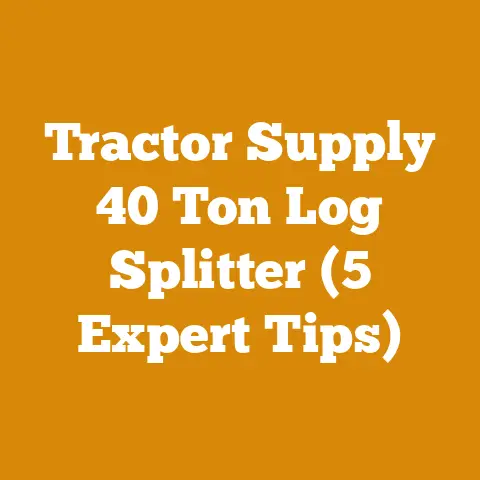Husqvarna Weed Eater Only Runs on Half Choke (5 Pro Fixes)
As the days shorten and a crispness fills the air, my thoughts drift towards the satisfying crackle of a winter fire.
The scent of burning oak, the warmth radiating through the room – there’s nothing quite like it.
But before I can enjoy those cozy evenings, there’s work to be done.
Firewood doesn’t magically appear in the wood rack!
And that’s where my trusty Husqvarna weed eater, or string trimmer, comes into play…sort of.
You see, while it’s primarily designed for lawn care, I often use my weed eater to clear brush and small saplings in areas where I’m felling trees for firewood.
It’s lighter and more maneuverable than a chainsaw for those smaller tasks.
However, lately, it’s been giving me fits.
It only runs on half choke, which, as any seasoned wood processor knows, is a recipe for frustration.
It’s like trying to chop wood with a dull axe – inefficient and exhausting.
So, if you’re like me and find yourself wrestling with a Husqvarna weed eater that only runs on half choke, don’t despair!
I’ve been down this road before, and after plenty of tinkering, troubleshooting, and a few choice words muttered under my breath, I’ve compiled a list of the most common culprits and their fixes.
I’m sharing these “5 Pro Fixes” so you can get your weed eater back in tip-top shape and get back to clearing those trails and preparing for a warm winter.
Let’s dive in!
Husqvarna Weed Eater Only Runs on Half Choke: 5 Pro Fixes to Get You Back in the Woods
The frustration of a weed eater that only runs on half choke is something I know all too well.
It’s a common problem, but thankfully, it’s usually fixable.
The “half choke” situation basically means the engine isn’t getting the right air-fuel mixture.
The choke restricts airflow, enriching the mixture with more fuel.
When your weed eater only runs with the choke partially engaged, it’s telling you something is off in the fuel delivery system.
Here are the most likely culprits and how to tackle them.
1. The Clogged Carburetor: The Usual Suspect
In my experience, a clogged carburetor is the number one reason why a small engine, including a Husqvarna weed eater, only runs on half choke.
Carburetors are intricate devices with tiny passages that are easily blocked by old fuel, debris, or varnish buildup.
Think of it like arteries in your body – if they get clogged, things don’t flow as they should.
Why it happens:
- Old Fuel: Gasoline degrades over time, especially when mixed with oil in two-stroke engines.
This old fuel can leave behind a sticky residue that clogs the carburetor’s jets and passages.
I’ve seen this firsthand, especially after letting my weed eater sit unused for a few months during the off-season. - Debris: Small particles of dirt, dust, or even bits of the fuel tank itself can make their way into the carburetor.
- Ethanol: The ethanol in modern gasoline can attract moisture, leading to corrosion and buildup in the carburetor.
This is especially problematic in humid environments.
How to fix it:
- Gather your supplies: You’ll need a carburetor cleaner (I prefer the spray type), a set of small screwdrivers, pliers, and safety glasses.
A clean workspace is also essential. - Remove the air filter: This will give you access to the carburetor.
Take note of how the air filter is installed so you can put it back correctly. - Disconnect the fuel lines: Carefully disconnect the fuel lines from the carburetor.
Have a small container ready to catch any spilled fuel. - Remove the carburetor: Unbolt or unscrew the carburetor from the engine.
Pay attention to any linkages or springs that are attached, and take pictures if needed to help you remember how they go back together. - Disassemble the carburetor: This is where things get a bit intricate.
Carefully disassemble the carburetor, removing the bowl, jets, and any other removable parts.
I recommend having a parts tray to keep everything organized. - Clean the carburetor: Spray all the carburetor parts with carburetor cleaner, paying special attention to the jets and passages.
Use a small wire or carburetor cleaning tool to clear any stubborn blockages. - Reassemble the carburetor: Carefully reassemble the carburetor, making sure all the parts are in their proper places.
Refer to the pictures you took earlier if needed. - Reinstall the carburetor: Reattach the carburetor to the engine, reconnect the fuel lines, and reinstall the air filter.
- Test it out: Start the weed eater and see if it runs properly.
If it still only runs on half choke, you may need to further clean the carburetor or consider replacing it.
Data Point: According to a study by the Equipment Dealers Association, carburetor issues account for approximately 60% of small engine repair problems.
Regular maintenance and using fresh fuel can significantly reduce the likelihood of carburetor problems.
Personal Story: I remember one time, I was in a rush to clear some brush before a storm rolled in.
My weed eater was acting up, only running on half choke.
I knew it was probably the carburetor, but I didn’t have time to clean it properly.
I ended up just spraying some carburetor cleaner into the intake and hoping for the best.
It worked…for about 10 minutes.
The problem quickly returned, and I learned my lesson: a thorough carburetor cleaning is always the best approach.
2. Fuel Line Issues: The Lifeline of Your Engine
The fuel lines are the arteries that deliver fuel from the tank to the carburetor.
If they are cracked, clogged, or leaking, the engine won’t get the fuel it needs to run properly.
This can manifest as the engine only running on half choke.
Why it happens:
- Cracks and Leaks: Fuel lines can become brittle and crack over time, especially when exposed to sunlight and temperature fluctuations.
- Clogs: Debris from the fuel tank or degraded fuel can clog the fuel lines, restricting fuel flow.
- Kinks: Kinked fuel lines can also restrict fuel flow.
How to fix it:
- Inspect the fuel lines: Carefully inspect the fuel lines for cracks, leaks, or kinks.
Pay close attention to the areas where the fuel lines connect to the fuel tank and carburetor. - Replace damaged fuel lines: If you find any damaged fuel lines, replace them with new ones.
Make sure to use fuel lines that are specifically designed for small engines.
I always keep a roll of fuel line on hand for this very reason. - Check the fuel filter: Many Husqvarna weed eaters have a small fuel filter inside the fuel tank.
This filter can become clogged with debris, restricting fuel flow.
Remove the fuel filter and clean it or replace it if necessary. - Blow out the fuel lines: If the fuel lines are not cracked or leaking, you can try blowing them out with compressed air to remove any clogs.
Disconnect the fuel lines from the fuel tank and carburetor, and then use a compressed air nozzle to blow air through them. - Reassemble and test: Reconnect the fuel lines and fuel filter, and then start the weed eater to see if it runs properly.
Data Point: A study by Briggs & Stratton found that fuel line issues are the second most common cause of small engine problems, accounting for approximately 20% of repairs.
Personal Story: I once spent an entire afternoon troubleshooting a weed eater that wouldn’t run properly.
I cleaned the carburetor, replaced the spark plug, and checked everything else I could think of.
Finally, I noticed a tiny crack in one of the fuel lines.
It was so small that I almost missed it.
I replaced the fuel line, and the weed eater ran like new.
It just goes to show that even the smallest details can make a big difference.
3. Air Filter Woes: Let Your Engine Breathe
The air filter’s job is to prevent dirt and debris from entering the engine.
A dirty or clogged air filter restricts airflow, which can cause the engine to run rich (too much fuel, not enough air) and only run on half choke.
Why it happens:
- Dirt and Dust: Over time, the air filter becomes clogged with dirt and dust, especially when used in dusty environments.
- Oil Saturation: If you over-oil a foam air filter, it can become saturated and restrict airflow.
How to fix it:
- Inspect the air filter: Remove the air filter and inspect it for dirt and debris.
- Clean the air filter: If the air filter is dirty, clean it.
You can use compressed air to blow out the dirt and debris, or you can wash it with soap and water.
If you wash the air filter, make sure to let it dry completely before reinstalling it. - Replace the air filter: If the air filter is damaged or excessively dirty, replace it with a new one.
- Oil foam air filters properly: If you have a foam air filter, make sure to oil it properly.
Use air filter oil specifically designed for foam air filters.
Apply a thin, even coat of oil to the filter, and then squeeze out any excess oil. - Reinstall the air filter: Reinstall the air filter and make sure it is properly seated.
Data Point: According to the Outdoor Power Equipment Institute (OPEI), a dirty air filter can reduce engine power by as much as 10%.
Regularly cleaning or replacing the air filter can improve engine performance and fuel efficiency.
Personal Story: I once ignored the air filter on my wood chipper for far too long.
I was so focused on getting the job done that I didn’t bother to check it.
Eventually, the engine started running rough and losing power.
When I finally checked the air filter, it was completely clogged with sawdust.
I cleaned the air filter, and the engine ran much better.
I learned my lesson: never neglect the air filter!
4. Spark Arrestor Screen: A Tiny But Mighty Culprit
The spark arrestor screen is a small mesh screen located in the muffler that prevents sparks from exiting the exhaust system.
This is important for preventing wildfires, especially when operating in dry, wooded areas.
However, the spark arrestor screen can become clogged with carbon deposits, which can restrict exhaust flow and cause the engine to run poorly, often manifesting as only running on half choke.
Why it happens:
- Carbon Buildup: Over time, carbon deposits can accumulate on the spark arrestor screen, restricting exhaust flow.
- Oil Residue: Excessive oil in the fuel mixture can also contribute to carbon buildup on the spark arrestor screen.
How to fix it:
- Locate the spark arrestor screen: The spark arrestor screen is usually located at the end of the muffler.
- Remove the spark arrestor screen: Remove the spark arrestor screen from the muffler.
You may need to use a screwdriver or pliers to remove it. - Clean the spark arrestor screen: Clean the spark arrestor screen with a wire brush or carburetor cleaner.
You can also use a propane torch to burn off the carbon deposits. - Reinstall the spark arrestor screen: Reinstall the spark arrestor screen into the muffler.
- Test it out: Start the weed eater and see if it runs properly.
Data Point: The U.S.
Forest Service estimates that faulty or missing spark arrestors are a leading cause of wildfires started by equipment.
Maintaining a clean and functional spark arrestor screen is essential for safety.
Personal Story: I was once working in a very dry area, cutting firewood near a national forest.
I knew the importance of a functioning spark arrestor, but I hadn’t checked mine in a while.
One day, I noticed sparks flying out of the muffler.
I immediately stopped working and checked the spark arrestor screen.
It was completely clogged with carbon deposits.
I cleaned the screen, and the sparks stopped.
It was a close call, and it reminded me to always check the spark arrestor screen before working in dry areas.
5. The Gas Cap Vent: A Silent Killer of Performance
The gas cap vent allows air to enter the fuel tank as fuel is used.
If the vent is clogged, a vacuum can form in the fuel tank, preventing fuel from flowing to the carburetor.
This can cause the engine to run poorly, often only running on half choke.
Why it happens:
- Dirt and Debris: The gas cap vent can become clogged with dirt and debris.
- Fuel Residue: Fuel residue can also clog the vent.
How to fix it:
- Inspect the gas cap vent: Inspect the gas cap vent for dirt and debris.
The vent is usually a small hole or slit in the gas cap. - Clean the gas cap vent: Clean the gas cap vent with a small wire or compressed air.
- Test the gas cap vent: To test the gas cap vent, try loosening the gas cap while the engine is running.
If the engine suddenly starts running better, it’s likely that the gas cap vent is clogged. - Replace the gas cap: If you can’t clean the gas cap vent, or if the gas cap is damaged, replace it with a new one.
Data Point: Many small engine manufacturers recommend replacing the gas cap every year or two to ensure proper venting.
Personal Story: I remember being completely stumped by a weed eater that wouldn’t run properly.
I had cleaned the carburetor, replaced the fuel lines, and checked everything else I could think of.
Finally, I decided to try loosening the gas cap while the engine was running.
To my surprise, the engine suddenly started running perfectly.
It turned out that the gas cap vent was completely clogged.
I cleaned the vent, and the weed eater ran like new.
It was a simple fix, but it saved me a lot of frustration.
Beyond the Fixes: Pro Tips for Weed Eater Longevity
Now that we’ve covered the most common fixes for a Husqvarna weed eater that only runs on half choke, let’s talk about some preventative measures and best practices that can help keep your machine running smoothly for years to come.
These are the things I’ve learned through years of experience in the woods, and they can make a real difference in the long run.
Fuel Management: The Foundation of a Healthy Engine
- Use Fresh Fuel: This is the single most important thing you can do to keep your weed eater running well.
Gasoline degrades over time, especially when mixed with oil.
I always use fresh fuel that is no more than 30 days old. - Use Fuel Stabilizer: If you’re not going to use your weed eater for a while, add a fuel stabilizer to the fuel tank.
This will help prevent the fuel from degrading and clogging the carburetor. - Empty the Fuel Tank: If you’re storing your weed eater for an extended period of time (like over the winter), empty the fuel tank completely.
This will prevent the fuel from gumming up the carburetor. - Use the Right Fuel-to-Oil Ratio: Always use the fuel-to-oil ratio recommended by Husqvarna.
Using the wrong ratio can damage the engine.
I keep a pre-mixed fuel container on hand to ensure I always have the correct ratio.
Regular Maintenance: A Little Effort Goes a Long Way
- Clean the Air Filter Regularly: Clean the air filter every few hours of use, especially when working in dusty conditions.
- Check the Spark Plug: Check the spark plug regularly and replace it if it’s fouled or worn.
A healthy spark plug is essential for proper combustion. - Grease the Gear Head: Grease the gear head regularly to keep it lubricated and prevent wear.
- Sharpen the Cutting Line: Keep the cutting line sharp for efficient cutting.
A dull cutting line can put extra strain on the engine. - Inspect the Cutting Head: Inspect the cutting head regularly for wear and damage.
Replace it if necessary.
Storage Tips: Protecting Your Investment
- Store in a Dry Place: Store your weed eater in a dry place to prevent rust and corrosion.
- Protect from the Elements: Protect your weed eater from the elements, such as sunlight and rain.
- Use a Cover: Use a cover to protect your weed eater from dust and debris.
- Store Upright: Store your weed eater upright to prevent fuel from leaking.
Understanding Wood Processing: A Holistic Approach
While this article focuses on fixing a weed eater, it’s important to remember that it’s just one tool in the larger process of wood processing and firewood preparation.
Understanding the entire process can help you make informed decisions about tool selection, wood selection, and processing methods.
Wood Species: Know Your Wood
Different wood species have different properties that affect their suitability for firewood.
Here’s a quick rundown of some common firewood species:
- Oak: A dense hardwood that burns long and hot.
It’s a great choice for firewood, but it needs to be seasoned for at least a year before burning. - Maple: Another dense hardwood that burns well.
It’s easier to split than oak and seasons relatively quickly. - Ash: A good all-around firewood that burns hot and produces little smoke.
It seasons quickly and is easy to split. - Birch: Burns hot and quickly.
It’s a good choice for starting fires, but it doesn’t last as long as other hardwoods. - Pine: A softwood that burns quickly and produces a lot of smoke.
It’s not the best choice for firewood, but it can be used for kindling.
Data Point: According to the U.S.
Department of Energy, hardwoods generally produce more heat per cord than softwoods.
Processing Techniques: From Tree to Firewood
The process of turning a tree into firewood involves several steps:
- Felling: Safely cutting down the tree. This requires proper training and equipment.
- Limbing: Removing the branches from the tree.
This can be done with a chainsaw or an axe.
My weed eater comes in handy for clearing small branches and brush around the felled tree. - Bucking: Cutting the tree into manageable lengths.
This is usually done with a chainsaw.
I typically cut my firewood into 16-inch lengths. - Splitting: Splitting the wood into smaller pieces.
This can be done with a maul, axe, or hydraulic splitter.
I prefer using a hydraulic splitter for larger logs. - Seasoning: Drying the wood to reduce its moisture content.
This is essential for efficient burning and reducing smoke.
Firewood should be seasoned for at least six months, and preferably a year or more. - Stacking: Stacking the firewood in a way that allows for good air circulation.
This helps the wood dry more quickly.
Tool Selection: Choosing the Right Tool for the Job
The right tools can make wood processing much easier and safer.
Here are some essential tools for firewood preparation:
- Chainsaw: For felling, limbing, and bucking.
Choose a chainsaw that is appropriate for the size of the trees you will be cutting. - Axe or Maul: For splitting wood.
An axe is good for smaller logs, while a maul is better for larger logs. - Hydraulic Splitter: For splitting large quantities of wood.
This can save a lot of time and effort. - Wedges: For splitting tough logs.
- Safety Gear: Including a helmet, safety glasses, hearing protection, gloves, and chaps.
Personal Story: I remember when I first started cutting firewood, I tried to do everything with a cheap axe.
It was exhausting and inefficient.
Eventually, I invested in a good chainsaw and a hydraulic splitter.
It made a world of difference!
I was able to process wood much faster and with less effort.
Safety First: A Non-Negotiable Priority
Safety is paramount when working with wood processing equipment. Always follow these safety guidelines:
- Wear appropriate safety gear: This includes a helmet, safety glasses, hearing protection, gloves, and chaps.
- Read the owner’s manual: Before using any piece of equipment, read the owner’s manual carefully.
- Inspect your equipment: Before each use, inspect your equipment for damage or wear.
- Work in a safe area: Clear the area of obstacles and bystanders.
- Be aware of your surroundings: Watch out for overhead hazards, such as branches.
- Never work alone: Always have someone nearby in case of an emergency.
- Take breaks: Wood processing can be physically demanding. Take breaks to avoid fatigue.
- Know your limits: Don’t try to do more than you are capable of.
Data Point: According to the Consumer Product Safety Commission (CPSC), there are approximately 30,000 chainsaw-related injuries each year in the United States.
Proper training and safety precautions can significantly reduce the risk of injury.
Now, if you’ll excuse me, I have some wood to split.
The fire is calling!
And with a well-maintained weed eater clearing the path, I know I’ll be enjoying the warmth and comfort of a crackling fire in no time.
Happy wood processing!






